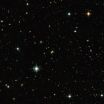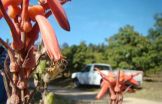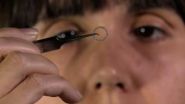(Press-News.org) Many galaxies have a giant black hole at their centre that causes the gas around it to glow. However, in the case of green bean galaxies, the entire galaxy is glowing, not just the centre. These new observations reveal the largest and brightest glowing regions ever found, thought to be powered by central black holes that were formerly very active but are now switching off.
Astronomer Mischa Schirmer of the Gemini Observatory had looked at many images of the distant Universe, searching for clusters of galaxies, but when he came across one object in an image from the Canada-France-Hawaii Telescope he was stunned -- it looked like a galaxy, but it was bright green. It was unlike any galaxy he had ever seen before, something totally unexpected. He quickly applied to use ESO's Very Large Telescope to find out what was creating the unusual green glow [1].
"ESO granted me special observing time at very short notice and just a few days after I submitted my proposal, this bizarre object was observed using the VLT," says Schirmer. "Ten minutes after the data were taken in Chile, I had them on my computer in Germany. I soon refocused my research activities entirely as it became apparent that I had come across something really new."
The new object has been labelled J224024.1−092748 or J2240. It liesin the constellation of Aquarius (The Water Bearer) and its light has taken about 3.7 billion years to reach Earth.
After the discovery, Schirmer's team searched through a list of nearly a billion other galaxies [2] and found 16 more with similar properties, which were confirmed by observations made at the Gemini South telescope. These galaxies are so rare that there is on average only one in a cube about 1.3 billion light-years across. This new class of galaxies has been nicknamed green bean galaxies because of their colour and because they are superficially similar to, but larger than, green pea galaxies [3].
In many galaxies the material around the supermassive black hole at the centre gives off intense radiation and ionises the surrounding gas so that it glows strongly. These glowing regions in typical active galaxies are usually small, up to 10% of the diameter of the galaxy. However, the team's observations showed that in the case of J2240, and other green beans spotted since, it is truly huge, spanning the entire object. J2240 displays one of the biggest and brightest such regions ever found. Ionised oxygen glows bright green, which explains the strange colour that originally caught Schirmer's attention.
"These glowing regions are fantastic probes to try to understand the physics of galaxies -- it's like sticking a medical thermometer into a galaxy far, far away," says Schirmer. "Usually, these regions are neither very large nor very bright, and can only be seen well in nearby galaxies. However, in these newly discovered galaxies they are so huge and bright that they can be observed in great detail, despite their large distances."
The team's further analysis of the data soon revealed another puzzle. J2240 appeared to have a much less active black hole at its centre than expected from the size and brightness of the glowing region. The team thinks that the glowing regions must be an echo from when the central black hole was much more active in the past, and that they will gradually dim as the remnants of radiation pass through them and out into space [4].
These galaxies signal the presence of a fading galactic centre, marking a very fleeting phase in a galaxy's life. In the early Universe galaxies were much more active, growing massive black holes at their centres that swallowed up surrounding stars and gas and shining brilliantly, easily producing up to 100 times more light than all the stars in the galaxy together. Light echoes like that seen in J2240 allow astronomers to study the shutdown processes of these active objects to understand more about how, when, and why they halt -- and why we now see so few of them in younger galaxies. This is what the team aims to do next, by following up on this research with further X-ray and spectroscopic observations.
"Discovering something genuinely new is an astronomer's dream come true, a once-in-a-lifetime event," concludes Schirmer. "It's very inspiring!"
INFORMATION:
Notes
[1] The astronomers studied the object using the powerful X-shooter spectrograph on the VLT. By splitting the light up into its component colours they could find out the composition of the glowing material and why it was shining so brightly.
[2] The search was made using the huge online database of the Sloan Digital Sky Survey (SDSS).
[3] Green Pea galaxies are small, luminous galaxies undergoing vigorous star formation. They were first spotted in 2007 by participants in the astronomical crowd-sourcing project Galaxy Zoo. Unlike green beans, these galaxies are very small -- our Milky Way galaxy contains a mass equivalent to that of around 200 average green pea galaxies. The similarity between green pea and green bean galaxies is limited to their appearance, as most of them are not closely related.
[4] In many active galaxies the view of the central black hole is blocked by large amounts of dust, making it difficult to measure the activity of the black hole. To check whether green bean galaxies are indeed different from other galaxies with hidden centres, the astronomers looked at data from these galaxies at much longer infrared wavelengths that easily penetrate even very thick dust clouds. The central regions of J2240, and the other green bean galaxies, turned out to be much fainter than expected. This means that the active nucleus is now really much weaker than suggested by the brightness of the glowing regions.
More information
This research was presented in a paper, "A sample of Seyfert-2 galaxies with ultra-luminous galaxy-wide NLRs - Quasar light echos?", to appear in The Astrophysical Journal.
The team is composed of M. Schirmer (Gemini Observatory, Chile; Argelander-Institut fur Astronomie, Universitat Bonn, Germany), R. Diaz (Gemini Observatory, Chile), K. Holhjem (SOAR Telescope, Chile), N. A. Levenson (Gemini Observatory, Chile) and C. Winge (Gemini Observatory, Chile).
Photos of the VLT: http://www.eso.org/public/images/archive/category/paranal/
The year 2012 marks the 50th anniversary of the founding of the European Southern Observatory (ESO). ESO is the foremost intergovernmental astronomy organisation in Europe and the world's most productive ground-based astronomical observatory by far. It is supported by 15 countries: Austria, Belgium, Brazil, the Czech Republic, Denmark, France, Finland, Germany, Italy, the Netherlands, Portugal, Spain, Sweden, Switzerland and the United Kingdom. ESO carries out an ambitious programme focused on the design, construction and operation of powerful ground-based observing facilities enabling astronomers to make important scientific discoveries. ESO also plays a leading role in promoting and organising cooperation in astronomical research. ESO operates three unique world-class observing sites in Chile: La Silla, Paranal and Chajnantor. At Paranal, ESO operates the Very Large Telescope, the world's most advanced visible-light astronomical observatory and two survey telescopes. VISTA works in the infrared and is the world's largest survey telescope and the VLT Survey Telescope is the largest telescope designed to exclusively survey the skies in visible light. ESO is the European partner of a revolutionary astronomical telescope ALMA, the largest astronomical project in existence. ESO is currently planning the 39-metre European Extremely Large optical/near-infrared Telescope, the E-ELT, which will become "the world's biggest eye on the sky".
The Gemini Observatory is an international collaboration with two identical 8-meter telescopes. The Frederick C. Gillett Gemini Telescope is located on Mauna Kea, Hawai'i (Gemini North) and the other telescope on Cerro Pachon in central Chile (Gemini South); together the twin telescopes provide full coverage over both hemispheres of the sky. The telescopes incorporate technologies that allow large, relatively thin mirrors, under active control, to collect and focus both visible and infrared radiation from space.
The Gemini Observatory provides the astronomical communities in seven partner countries with state-of-the-art astronomical facilities that allocate observing time in proportion to each country's contribution. In addition to financial support, each country also contributes significant scientific and technical resources. The national research agencies that form the Gemini partnership include: the US National Science Foundation (NSF); the UK Science and Technology Facilities Council (STFC); the Canadian National Research Council (NRC); the Chilean Comision Nacional de Investigacion Cientifica y Tecnologica (CONICYT); the Australian Research Council (ARC); the Argentinean Ministerio de Ciencia, Tecnologia e Innovacion Productiva; and the Brazilian Ministerio da Ciencia, Tecnologia e Inovaçao. The observatory is managed by the Association of Universities for Research in Astronomy, Inc. (AURA) under a cooperative agreement with the NSF. The NSF also serves as the executive agency for the international partnership.
The Canada-France-Hawaii Telescope (CFHT) is operated by the National Research Council of Canada, the Institut National des Sciences de l'Univers of the Centre National de la Recherche Scientifique of France, and the University of Hawaii.
Contacts
Mischa Schirmer
Science Fellow, Gemini Observatory
La Serena, Chile
Tel: 56-51-205-600
Email: mschirme@gemini.edu
Daniel Devost
Canada-France-Hawaii Telescope
Kamuela, Hawaii, USA
Tel: 808-885-3163
Email: devost@cfht.hawaii.edu
Peter Michaud
Gemini Observatory
Tel: 808-974-2510
Email: pmichaud@gemini.edu
Galaxy-wide echoes from the past
VLT observations identify very rare new kind of galaxy
2012-12-05
ELSE PRESS RELEASES FROM THIS DATE:
Mayo Clinic: Less invasive surgery detects residual breast cancer in lymph nodes after chemotherapy
2012-12-05
ROCHESTER, Minn. — Most patients whose breast cancer has spread to their lymph nodes have most of the lymph nodes in their armpit area removed after chemotherapy to see if any cancer remains. A study conducted through the American College of Surgeons Oncology Group and led by Judy Boughey, M.D. a breast surgeon at Mayo Clinic shows that a less invasive procedure known as sentinel lymph node surgery successfully identified whether cancer remained in lymph nodes in 91 percent of patients with node-positive breast cancer who received chemotherapy before their surgery. In sentinel ...
Scientists pinpoint great-earthquake hot spots
2012-12-05
"We find that 87% of the 15 largest (8.6 magnitude or higher) and half of the 50 largest (8.4 magnitude or higher) earthquakes of the past century are associated with intersection regions between oceanic fracture zones and subduction zones," says Dietmar Müller, researcher at the University of Sydney in Australia and lead author of the Solid Earth paper. The connection is less striking for smaller earthquakes.
Powerful earthquakes related to these intersection regions include the destructive 2011 Tohoku-Oki and 2004 Sumatra events.
"If the association we found were ...
URI oceanography student uses crashing waves on shorelines to study Earth's interior
2012-12-05
NARRAGANSETT, R.I. – December 5, 2012 – Scientists have long used the speed of seismic waves traveling through the Earth as a means of learning about the geologic structure beneath the Earth's surface, but the seismic waves they use have typically been generated by earthquakes or man-made explosions. A University of Rhode Island graduate student is using the tiny seismic waves created by ocean waves crashing on shorelines around the world to learn how an underwater plateau was formed 122 million years ago.
"There are any number of ways to create seismic waves, but most ...
Wind speeds in southern New England declining inland, remaining steady on coast
2012-12-05
NARRAGANSETT, R.I. – December 5, 2012 – Oceanographers at the University of Rhode Island have analyzed long-term data from several anemometers in southern New England and found that average wind speeds have declined by about 15 percent at inland sites while speeds have remained steady at an offshore site.
Kelly Knorr, a graduate student at the URI Graduate School of Oceanography, and Professor John Merrill reported the results of their research today at the fall meeting of the American Geophysical Union in San Francisco.
The researchers found that average wind speeds ...
Gladstone scientists: 'ApoE is an ideal target for halting progression of Alzheimer's disease'
2012-12-05
SAN FRANCISCO, CA—December 5, 2012—Despite researchers' best efforts, no drug exists that can slow, halt or reverse the onslaught of Alzheimer's disease. A progressive and fatal neurodegenerative disorder, Alzheimer's has stolen the memories and livelihoods of millions—leaving patients and their families struggling to cope with the disease's devastating consequences. But today, scientists at the Gladstone Institutes propose a new research avenue that has the potential to change all that.
In the latest issue of the journal Neuron, available today online, Gladstone Investigators ...
Africa's Homo sapiens were the first techies
2012-12-05
The search for the origin of modern human behaviour and technological advancement among our ancestors in southern Africa some 70 000 years ago, has taken a step closer to firmly establishing Africa, and especially South Africa, as the primary centre for the early development of human behaviour.
A new research paper by renowned Wits University archaeologist, Prof. Christopher Henshilwood, is the first detailed summary of the time periods he and a group of international researchers have been studying in South Africa: namely the Still Bay techno-traditions (c. 75 000 – 70 ...
Discovery of 100 million-year-old regions of DNA shows short cut to crop science advances
2012-12-05
Scientists have discovered 100 million-year-old regions in the DNA of several plant species which could hold secrets about how specific genes are turned 'on' or 'off'.
The findings, which are hoped will accelerate the pace of research into crop science and food security, are detailed by University of Warwick researchers in the journal The Plant Cell.
By running a computational analysis of the genomes of the papaya, poplar, Arabidopsis and grape species, scientists have uncovered hundreds of conserved non-coding sequences which are found in the DNA of all four species.
These ...
Small patches of native plants help boost pollination services in large farms
2012-12-05
A combined team of scientists from Europe and South Africa (Luísa G. Carvalheiro (University of Leeds, UK & Naturalis Biodiversity Research Centre, Netherlands), Colleen Seymour and Ruan Veldtman (SANBI, South Africa) and Sue Nicolson (University of Pretoria)) have discovered that pollinator services of large agriculture fields can be enhanced with a simple cost-effective measure, that involves the creation of small patches of native plants within fruit orchards.
"Mango farmers in South Africa are aware of the pollination limitation of this crop and invest a substantial ...
New technique to deliver stem cell therapy may help damaged eyes regain their sight
2012-12-05
In research published in the journal Acta Biomaterialia, researchers from the University of Sheffield describe a new method for producing membranes to help in the grafting of stem cells onto the eye, mimicking structural features of the eye itself. The technology has been designed to treat damage to the cornea, the transparent layer on the front of the eye, which is one of the major causes of blindness in the world.
Using a combination of techniques known as microstereolithography and electrospinning, the researchers are able to make a disc of biodegradable material which ...
An inadequate diet during pregnancy predisposes the baby to diabetes
2012-12-05
Experts already know that pregnant women should not eat for two. A study now insists on the importance of a healthy diet as a way of avoiding increased insulin and glucose levels in the child, both of which are indicators of diabetes and metabolic syndrome risk.
Maternal diet quality during pregnancy is fundamental to foetal growth as well as insulin and glucose levels at birth. Such indications warn of the possible predisposition to suffer from illnesses like diabetes and metabolic syndrome.
The study was headed by the Complutense University of Madrid and published ...
LAST 30 PRESS RELEASES:
“Gifted word learner” dogs can pick up new words by overhearing their owners’ talk
More data, more sharing can help avoid misinterpreting “smoking gun” signals in topological physics
An illegal fentanyl supply shock may have contributed to a dramatic decline in deaths
Some dogs can learn new words by eavesdropping on their owners
Scientists trace facial gestures back to their source. before a smile appears, the brain has already decided
Is “Smoking Gun” evidence enough to prove scientific discovery?
Scientists find microbes enhance the benefits of trees by removing greenhouse gases
KAIST-Yonsei team identifies origin cells for malignant brain tumor common in young adults
Team discovers unexpected oscillation states in magnetic vortices
How the brain creates facial expressions
Researchers observe gas outflow driven by a jet from an active galactic nucleus
Pitt student finds familiar structure just 2 billion years after the Big Bang
Evidence of cross-regional marine plastic pollution in green sea turtles
Patients with clonal hematopoiesis have increased heart disease risk following cancer treatment
Stem cell therapy for stroke shows how cells find their way in the brain
Environment: Up to 4,700 tonnes of litter flows down the Rhine each year
Maternal vaccine receipt and infant hospital and emergency visits for influenza and pertussis
Interim safety of RSVpreF vaccination during pregnancy
Stem cell engineering breakthrough paves way for next-generation living drugs
California grants $7.4 million to advance gene-edited stem cell therapy for Friedreich’s ataxia
Victoria’s Secret grant backs cutting-edge ovarian cancer research
Research paves the way for safer colonoscopy bowel prep for people with compromised gut health
JMIR Publications and Sweden's National Library announce renewal and expansion of flat-fee unlimited open access partnership for 2026
A new 3D-printed solar cell that’s transparent and color-tunable
IV iron is the cost-effective treatment for women with iron deficiency anemia and heavy menstrual bleeding
Doing good pays off: Environmentally and socially responsible companies drive value and market efficiency
City of Hope and Cellares to automate manufacturing of solid tumor CAR T cell therapy
Short-circuiting pancreatic cancer
Groundbreaking mapping: how many ghost particles all the Milky Way’s stars send towards Earth
JBNU researchers propose hierarchical porous copper nanosheet-based triboelectric nanogenerators
[Press-News.org] Galaxy-wide echoes from the pastVLT observations identify very rare new kind of galaxy




